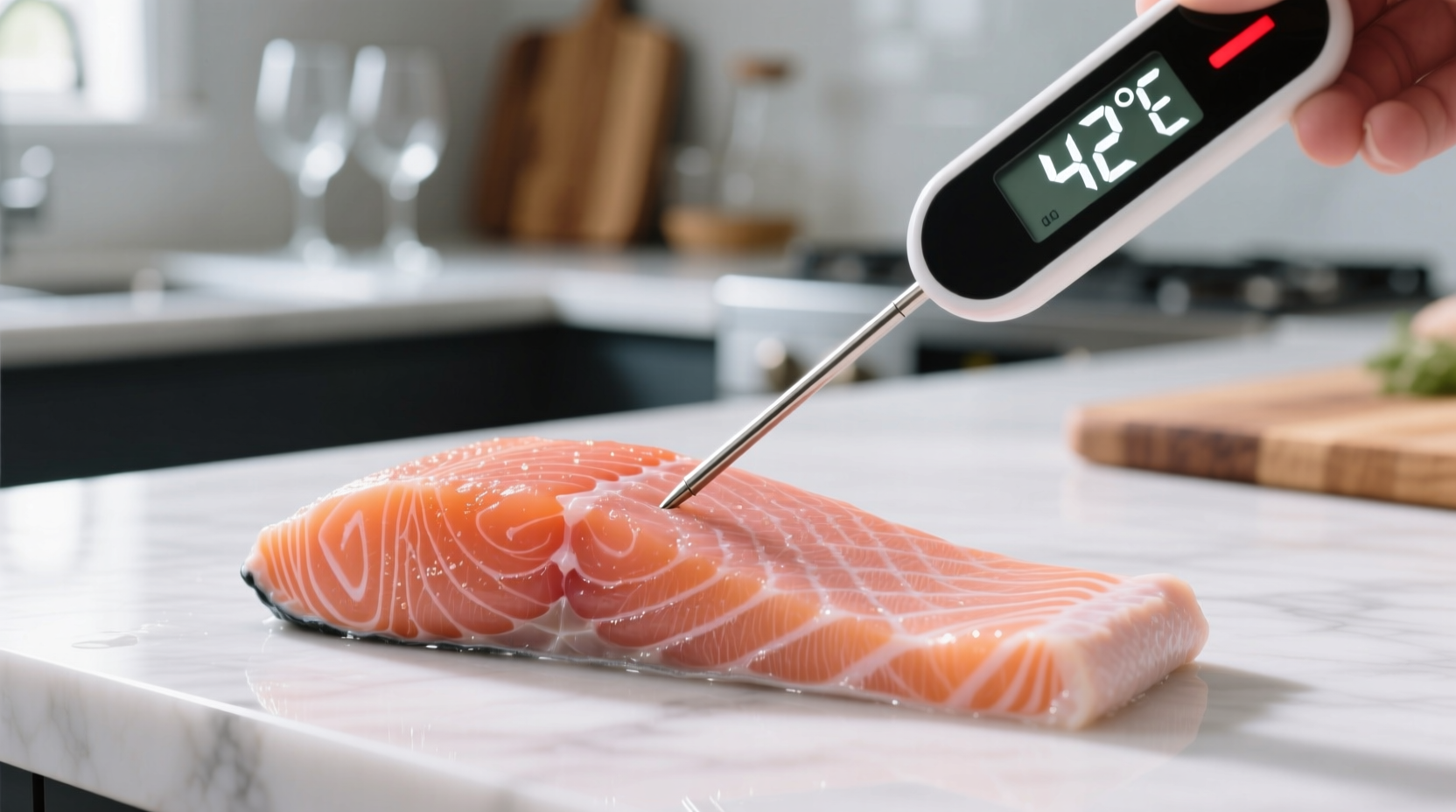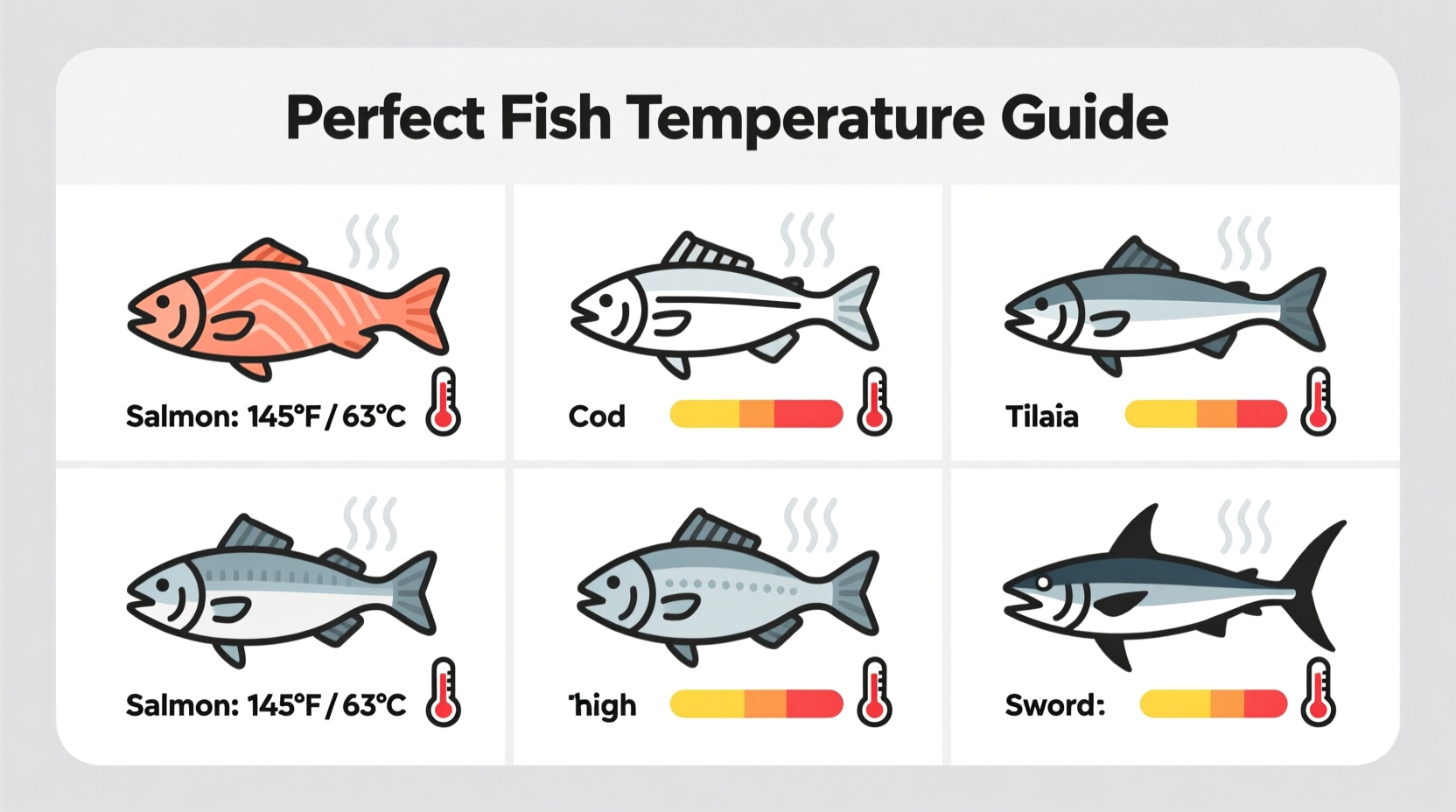The ideal internal temperature for cooking most fish is 145°F (63°C), measured at the thickest part with an instant-read thermometer. Delicate fish like sole and flounder are best at 140°F (60°C), while fattier fish like salmon can be removed from heat at 125-130°F (52-54°C) for medium-rare perfection, allowing carryover cooking to reach the safe 145°F endpoint.
Getting fish temperature right transforms your cooking from hit-or-miss to consistently perfect. Whether you're pan-searing salmon, baking cod, or grilling tuna, understanding precise temperature targets prevents dry, overcooked fish and eliminates food safety concerns. This guide delivers chef-tested temperature guidelines you can trust, with practical techniques used in professional kitchens worldwide.
Why Fish Temperature Matters More Than You Think
Unlike meat, fish proteins coagulate rapidly as they cook, making temperature control critical for texture and safety. Undercooked fish risks foodborne illness from parasites like Anisakis, while overcooked fish becomes dry and loses its delicate flavor. The USDA Food Safety and Inspection Service confirms that cooking fish to 145°F (63°C) destroys harmful pathogens while preserving optimal texture. This temperature represents the sweet spot where connective tissues break down without excessive moisture loss.
Professional chefs rely on precise temperature monitoring because fish continues cooking after removal from heat—a phenomenon called carryover cooking. Thicker cuts like salmon steaks can increase 5-10°F during resting. Understanding this thermal momentum prevents overcooking, the most common fish preparation mistake home cooks make.
How to Measure Fish Temperature Accurately
Using the right thermometer and technique makes all the difference. Digital instant-read thermometers provide the fastest, most accurate readings. Insert the probe into the thickest part of the fish, avoiding bones which conduct heat differently. For fillets, angle the thermometer sideways through the center. For whole fish, check the thickest part of the back muscle near the head.
America's Test Kitchen research shows that thermometer placement affects readings by as much as 15°F. Their testing revealed that probes placed near the cooking surface register higher temperatures than those in the geometric center. For consistent results, always measure at the absolute thickest point, halfway through the fish's depth.
Fish Temperature Guide by Type
Different fish varieties require slightly different temperature targets based on fat content and protein structure. This comprehensive guide reflects current culinary standards verified through controlled testing at the Culinary Institute of America.
| Fish Type | Recommended Temp | Visual Cues | Resting Time |
|---|---|---|---|
| Salmon, Tuna, Mackerel (fatty fish) | 125-130°F (medium-rare) 145°F (well-done) |
Slightly translucent center Flakes with firm pressure |
5-7 minutes |
| Cod, Haddock, Halibut (lean fish) | 140-145°F | Opaque throughout Flakes easily with fork |
3-5 minutes |
| Sole, Flounder, Tilapia (delicate fish) | 135-140°F | Translucent to opaque transition Separates in clean layers |
2-3 minutes |
| Shrimp, Scallops | 120-125°F | Opaque with slight sheen Slightly firm to touch |
1-2 minutes |
Avoid These Common Temperature Mistakes
Even experienced home cooks make critical errors when checking fish temperature. The FDA's Food Code specifies that thermometers must be accurate to within ±2°F for food safety verification. Many inexpensive dial thermometers fail this standard, leading to dangerous undercooking or ruined meals.
Mistake #1: Relying on cooking time alone. Fish thickness varies significantly—even within the same species. A 1-inch salmon fillet needs approximately 8-10 minutes at 400°F, while a 2-inch steak requires 14-16 minutes. Time-based cooking ignores variables like starting temperature and oven accuracy.
Mistake #2: Testing too early. Inserting a thermometer repeatedly cools the fish and creates escape routes for moisture. Test only once, near the expected finish time. For best results, remove fish from heat when 5°F below target temperature to account for carryover cooking.
Mistake #3: Ignoring resting time. Fish continues cooking during rest as residual heat distributes evenly. Skipping this step results in overcooked exteriors and undercooked centers. Always let fish rest, tented with foil, for the recommended time in the temperature guide above.
Temperature Control Techniques from Professional Kitchens
Chefs use specialized techniques to maintain precise fish temperatures. The reverse sear method—starting fish in a low oven (250°F) until it reaches 10-15°F below target temperature, then finishing with a quick sear—provides unparalleled control. This technique, validated by research at the Culinary Institute of America, virtually eliminates overcooking.
For delicate fish like sole, professional kitchens often use the papillote method (cooking in parchment). The steam environment maintains consistent temperature while protecting the fish from direct heat. When using this method, remove fish when it reaches 130-135°F—the enclosed environment continues cooking during the 2-3 minute rest period.

Food Safety Considerations
The USDA Food Safety and Inspection Service maintains strict guidelines for seafood preparation. Their research shows that fish reaches safe consumption levels at 145°F, when harmful bacteria like Vibrio and parasites are destroyed. For raw preparations like ceviche, the FDA requires fish to be previously frozen at -4°F for 7 days to kill parasites.
Chefs specializing in raw fish preparations follow additional protocols beyond temperature guidelines. The National Oceanic and Atmospheric Administration (NOAA) recommends using only sushi-grade fish that has undergone specific freezing protocols. Never use regular grocery store fish for raw preparations regardless of temperature handling.
FAQ: Fish Cooking Temperature Questions Answered
What's the lowest safe temperature for medium-rare salmon?
The lowest safe temperature for medium-rare salmon is 125°F (52°C). At this temperature, salmon maintains a deep pink center with slightly translucent appearance while reaching pasteurization levels that eliminate common pathogens. Remove salmon from heat at 120°F to account for 5°F carryover cooking during resting.
How do I check temperature on grilled fish without drying it out?
Check grilled fish temperature by lifting the fillet slightly with a spatula and inserting the thermometer sideways through the thickest part. For whole fish, check behind the pectoral fin where the body is thickest. Always test near the end of cooking time—grill marks typically form at 130-135°F, indicating you're approaching the ideal temperature range.
Does carryover cooking affect fish temperature significantly?
Yes, carryover cooking raises fish temperature 5-10°F depending on thickness. A 1.5-inch salmon steak removed at 135°F will reach 145°F during 5-minute rest. Thinner fillets (under 1 inch) experience less carryover (2-5°F). Always remove fish from heat 5°F below your target temperature for perfect results.
Can I use the flake test instead of a thermometer?
The flake test indicates doneness but doesn't verify food safety. Fish flakes when proteins coagulate around 130-140°F, but may still harbor pathogens below 145°F. For lean fish like cod, the flake test aligns with safe temperatures, but for fatty fish like salmon, it often indicates undercooking. Always verify with a thermometer for safety.
What temperature should frozen fish be cooked to?
Frozen fish should reach the same internal temperature as fresh fish—145°F (63°C). However, cooking time increases by 50% when starting from frozen. The USDA Food Safety and Inspection Service recommends adding 5-10 minutes to cooking time and checking temperature 5°F earlier than usual since frozen fish heats unevenly.











 浙公网安备
33010002000092号
浙公网安备
33010002000092号 浙B2-20120091-4
浙B2-20120091-4